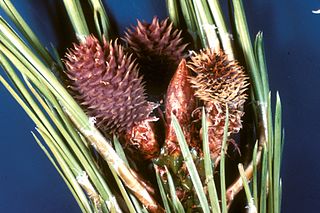
Neodactria is a genus of moths of the family Crambidae.

Chrysoteuchia topiarius, the topiary grass-veneer moth, subterranean sod webworm or cranberry girdler, is a moth of the family Crambidae. The species was first described by Philipp Christoph Zeller in 1866. It is found in most of North America.

Dioryctria auranticella, the ponderosa pineconeworm moth, is a moth of the family Pyralidae. The species was first described by Augustus Radcliffe Grote in 1883. It is found in western North America from southern British Columbia south to California and Arizona, east to South Dakota and New Mexico.
Alexander Barrett Klots was an American entomologist who specialised in Lepidoptera.
Neodactria caliginosellus, the corn root webworm or black grass-veneer, is a moth in the family Crambidae. It was described by James Brackenridge Clemens in 1860. It is found in North America, where it has been recorded from Alabama, Alberta, California, Florida, Georgia, Illinois, Indiana, Maine, Maryland, Mississippi, North Carolina, Ohio, Oklahoma, Ontario, South Carolina and Tennessee. The habitat consists of grassy areas and fields.
Neodactria glenni is a moth in the family Crambidae. It was described by Bernard Landry and Alexander Barrett Klots in 2002. It is found in North America, where it has been recorded from central and east-central Missouri, upper central Illinois and eastern Mississippi. The habitat consists of prairies.
Neodactria oktibbeha is a moth in the family Crambidae. It was described by Bernard Landry and Richard L. Brown in 2005. It is found in central Mississippi, where it is only known from prairie remnants in the Black Belt of Oktibbeha and Lowndes counties.
Neodactria cochisensis is a moth in the family Crambidae. It was described by Bernard Landry and Valeriu Albu in 2012. It is found in North America, where it has been recorded from the Huachuca Mountains and Chiricahua Mountains in Arizona.
Stegasta francisci is a moth of the family Gelechiidae. It was described by Bernard Landry in 2010. It is found on the Galápagos Islands and in continental Ecuador.
Scrobipalpula caustonae is a moth in the family Gelechiidae. It was described by Bernard Landry in 2010. It is found on the Galápagos Islands.
Untomia lunatella is a moth of the family Gelechiidae. It was described by Bernard Landry in 2010. It is found on the Galápagos Islands.
Galagete cinerea is a moth in the family Autostichidae. It was described by Bernard Landry in 2002. It is found on the Galápagos Islands.
Galagete consimilis is a moth in the family Autostichidae. It was described by Bernard Landry in 2002. It is found on the Galápagos Islands.
Galagete cristobalensis is a moth in the family Autostichidae. It was described by Bernard Landry in 2002. It is found on the Galápagos Islands.
Galagete espanolaensis is a moth in the family Autostichidae. It was described by Bernard Landry in 2002. It is found on the Galápagos Islands.
Galagete levequei is a moth in the family Autostichidae. It was described by Bernard Landry in 2002. It is found on the Galápagos Islands.
Galagete pecki is a moth in the family Autostichidae. It was described by Bernard Landry in 2002. It is found on the Galápagos Islands.
Galagete seymourensis is a moth in the family Autostichidae. It was described by Bernard Landry in 2002. It is found on the Galápagos Islands.
Galagete turritella is a moth in the family Autostichidae. It was described by Bernard Landry in 2002. It is found on the Galápagos Islands.
Galagete krameri is a moth in the family Autostichidae. It was described by Bernard Landry and Patrick Schmitz in 2008. It is found on the Galápagos Islands.


